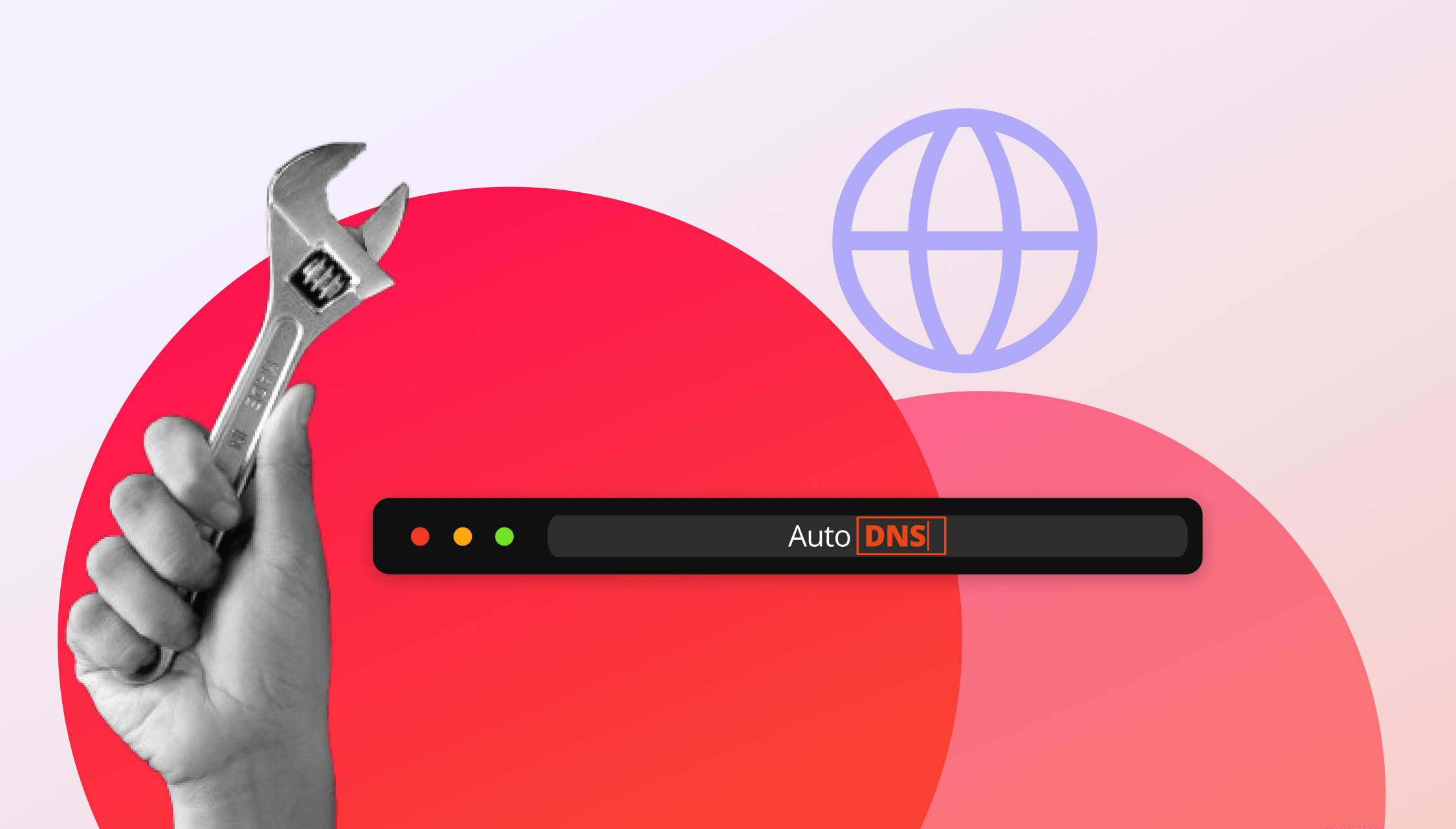
Domain management tools | How to manage your domains

Effective domain management is for optimizing operational efficiency, maintaining robust security protocols, and streamlining portfolio scalability. Discover how professional domain management tools like AutoDNS allow for centralized control, automation and future-proof management of complex domain portfolios.
Published by

Thomas Pezza
Date
Domains are at the core of your brand identity. They also serve as the entry point for customers and provide the foundation for online security. For businesses of all sizes, efficiently managing domain portfolios is a vital task. As the number of TLDs grows and security and legal requirements become more complex, the challenges also increase. This is where domain management tools come in—they provide professional solutions to manage these complexities in a centralized, forward-thinking way.One particularly powerful tool is AutoDNS from InterNetX, designed to help businesses, agencies, and resellers manage their domains professionally. Discover what sets solutions like AutoDNS apart, what factors to consider when choosing one, and the tasks involved in effective domain management.
What is a domain management tool?
A domain management tool is a software solution that allows businesses to centrally manage their domain names and all related services, including DNS zones, TLS/SSL certificates, and renewal management. It streamlines the organization and optimization of large domain portfolios through a single platform.
The need for these tools is growing. They help businesses remain agile, maintain consistent brand identity, and secure their digital infrastructure. By automating tasks and providing transparency, they reduce the reliance on manual processes. Domain management software also plays an important role in risk mitigation by offering timely alerts before SSL/TLS certificates expire, enabling automatic renewals, and identifying potential DNS vulnerabilities early. This proactive approach to safeguarding technical infrastructure significantly improves operational security.
What are the core functionalities of domain management software?
A powerful domain management tool combines numerous features that cover the entire lifecycle of domains. It involves not only management in the strictest sense but also the automation of the entire portfolio.
Advanced analytics for data-driven decisions
Informed decisions start with solid data. A modern domain management tool, therefore, offers detailed analytics and customizable reporting options. Below is a detailed list of insights one can obtain using such tools:
1Domain ownership and registration data
- WHOIS data information: Retrieve registrar details, registrant contact information, registration dates (creation, expiration, and last update).
- Privacy status: Check whether the domain has enabled WHOIS privacy protection.
- Domain age: Access the age of the domain for evaluating trustworthiness and historical value.
2Domain valuation
- Domain value estimate: Evaluate the domain’s monetary worth based on demand, length, keywords, and sales in comparable markets.
- Historical sales data: Insights on past sales trends for your domain or similar domains.
- Premium/brandability score: Assess the domain’s suitability for branding or its market attractiveness.
3Domain authority and trustworthiness
- Domain authority score: Assess the domain’s authority score for SEO purposes (based on metrics like backlinks, quality of referring domains, etc.).
- Spam score: Detect whether the domain has a history of being flagged as spam.
- Trust score: Evaluate the trustworthiness of the domain.
4DNS and infrastructure insights
- DNS records lookup: View and manage DNS records like A/AAAA, MX, CNAME, TXT, and others for technical insights.
- Name server information: Identify current and historical name servers to understand hosting changes.
- Subdomains analysis: Analyze subdomains tied to the main domain.
5Traffic insights
- Organic traffic estimate: Check the approximate volume of traffic associated with the domain.
- Search engine rankings: Review rankings for keywords tied to the domain.
- Geographical traffic source: Inspect the geographical distribution of the traffic.
6Security and risk assessment
- Blacklist status: Determine if the domain is blacklisted in email or search engines.
- TLS/SSL certificate information: Check for the presence of SSL/TLS certificates and their validity.
- Phishing or malware alerts: Detect past usage of the domain for malicious purposes.
7Competitive analysis
- Market competitors: Find competitors’ domains within the same niche or industry.
- Keyword overlap: Analyze the keywords of your domain compared to competing domains.
- Domain auction trends: Get insights into similar domains selling in the domain aftermarket.
8Expiration and renewal forecasting
- Expiry date monitoring: Track the domain’s expiration date to avoid lapses.
- Renewal price trends: Understand registrar pricing trends for future renewals.
9Historical domain data
- Domain history: Access historical WHOIS data, ownership records, and registrars.
- Website history snapshots: Even though this is domain-specific, archive data like Wayback Machine records (e.g., what the domain has hosted in the past) could be relevant.
10Backlink analysis
- Quality of backlinks: Evaluate the backlinks pointing to the domain for SEO viability.
- Referring domains: View referring domains count and their quality ratings.
- Anchor text distribution: Check anchor text usage in backlinks to detect any spammy patterns.
11Auction and aftermarket insights
- Auction availability: Check whether the domain is listed in any marketplaces.
- Bidding insights: Analyze bidding trends for domains of similar types.
- Premium status: See if it’s a high-value domain in the aftermarket.
12Customizable reporting options
- Export Reports: Generate detailed reports on any of the above metrics.
- Custom metrics dashboard: Create personalized dashboards showing the most critical metrics for ongoing analysis.
- Historical trends visualization: Visualize changes in metrics like domain value, authority, and traffic over time.
By offering a combination of these insights, a modern domain management tool provides domain experts the data they need to make informed decisions about buying, selling, renewing, or holding domains efficiently.These insights help not only in strategically expanding your portfolio with new domains but also in identifying and eliminating unused or outdated domains. Additionally, automated alert systems allow for a quick response to critical events, enabling continuous adaptation and optimization of your domain strategy.
Intuitive user interfaces for efficient work
The best features are of little use if they’re hard to access or cumbersome to operate. Therefore, an intuitive user interface is essential for domain management tools. A well-designed dashboard provides clear structure, fast loading times, and easy navigation, making it simple to use even for those without technical knowledge. Standard tasks like registering new domains, editing DNS zones, or setting up TLS/SSL certificates can be efficiently executed with just a few clicks.
Additionally, modern domain management software offers role-based access systems, allowing different teams or departments to accurately access their areas of responsibility. This creates a seamless user experience, which in turn minimizes errors and accelerates processes.
Integration into domain marketplaces and aftermarkets
Professional domain management doesn’t end with the registration of your domains — it starts there. That’s why every powerful tool should offer direct integration with domain marketplaces and aftermarket platforms. By connecting to providers like thedomain platform Sedo, users can not only find available domains faster but also specifically search for premium and expired domains. What’s more, it provides the opportunity to actively offer your own domains for sale or to analyze their market values.
Who needs a domain management tool?
The demands of domain management are growing, regardless of industry or company size. As businesses expand to include multiple domains or serve international markets, a professional domain management tool becomes essential. Different user groups can make use of a tool’s broad range of features to meet their specific needs:
- Resellers: Resellers often manage hundreds or thousands of domains for different clients. A domain management tool with bulk functions, white-label options, and API integration enables efficient process control and automation.
- Brand managers: Protecting brand identity requires securing the the brand or trademark across different TLDs. Domain management tools help identify potential risks of abuse early on and ensure a Brand Keyword Monitoring in the name space.
- SaaS companies: For platform providers, technical reliability and scalability are crucial. An API-based solution allows domains, DNS records, and certificates to be managed automatically.
- Large companies: Large companies often have decentralized structures with multiple departments and markets. A central domain management tool provides a comprehensive overview, prevents unnecessary domain registrations, and promotes cross-department collaboration.
- Agencies and IT service providers: For agencies managing domains on behalf of their clients, such tools streamline and centralize tasks, making it easier to handle multiple domains efficiently.
What problems does domain management software solve?
Companies handling a large number of domains often face challenges. Domain management is typically spread across different systems, departments, or even external service providers, which can lead to inefficiencies, security vulnerabilities, and a lack of control.
1Time inefficiency
Manually managing domains is time-consuming and prone to errors. From registration to DNS configuration, without the appropriate tools each step needs to be done manually. What’s more, without automation, there’s a risk of missing deadlines, duplicating efforts, or making incorrect DNS entries. Domain management tools simplify these tasks, reducing them to just a few clicks. They automate recurring processes and ensure clear workflows for bulk registrations, domain renewals or multi-year domain registrations. This helps provide companies with long-term planning security.
2Scalability
As a company grows, and particularly when international expansion is involved, the number of domains it uses tends to increase. Managing these expanding portfolios quickly becomes a challenge. A scalable tool helps organize domains efficiently, enables bulk operations across different TLDs, and simplifies the management of complex DNS configurations, even across various languages and regions.
3Security risks
Misconfigurations in the DNS zone or missed certificate renewals can lead to serious domain security risks, including loss of accessibility or compromised sensitive data. Domain management tools help enforce security standards by supporting DNSSEC, automatically renewing TLS/SSL certificates, and implementing role-based user access. These features ensure domains remain up to date and prevent the misuse of administrative rights.
4Lack of overview
The larger the domain portfolio, the harder it is to maintain an overview. Domain management tools consolidate all data into a central dashboard. With clear representations, filter functions, and automated reports, companies can maintain constant control over their portfolio.
What should you consider when choosing a domain management tool?
The requirements for domain management software vary depending on the target audience. Resellers, for example, prioritize bulk features and integrations, while brand managers focus more on brand protection and performance monitoring. As a result, the tool must be flexible and scalable to suit different workflows. The features outlined below are particularly important for the following user groups:
-> Resellers
Resellers often manage hundreds or even thousands of domains for their clients, spanning multiple brands, regions, and requirements. As a result, an effective domain management tool needs to provide powerful bulk features. Additionally, advanced filter and search options in domain marketplaces are crucial for efficiently discovering and trading new domains.
Integration via a REST API is often essential, as this is the only way to seamlessly connect existing systems like shop solutions, customer centers, or billing systems. White-label features or the ability to manage users will be of added benefit to resellers.
-> Brand managers
For brand managers, protecting digital identity is a priority. A powerful domain management tool therefore needs to offer access to a wide range of TLDs and take into account country-specific and new generic extensions in order to cover global brand strategies. Precise search mechanisms also help secure relevant domains at an early stage and identify trademark infringements.
-> SaaS companies
SaaS providers require a domain management tool that smoothly integrates into their system architecture. Here, too, a robust REST API that can be used to automatically manage domains, DNS records and certificates is highly beneficial. Other important features include automated provisioning and renewal of SSL/TLS certificates, DNS templates for quick configurations, and the ability to map customer-specific workflows. The scalability of the platform is a critical factor here.
-> Large companies
Large companies often have decentralized structures with multiple brands, departments, or countries—making managing their domains equally complex. A central domain management tool with role-based access enables cross-department collaboration without losing track of the big picture or compromising security. Workflow-based tools help standardize processes. This approach should be further supported by granular reporting and export functions to back decision-making with data.
What tasks are involved in domain management?
Managing a domain is more than simply registering an address. Typical tasks include:
1Domain search and registration: Domain management tools such as AutoDNS allow you to find available domains or access premium offers in marketplaces.
2DNS zone and DNS record management: Managing nameservers, DNS records requires precision. A good domain management tool will allow for bulk changes and offer users helpful templates.
3TSL/SSL certificates: Security certificates are indispensable for trustworthy communication. Domain management tools should simplify setup and, most importantly, renewal.
4Renewals and deadlines: Keeping an eye on expiration dates is essential. Automated reminders and renewals help prevent downtime and accidental loss.
5Portfolio analysis and optimization: Which domains truly add value? Analyses support strategic decisions for reducing or expanding your domain portfolio.
How AutoDNS is revolutionizing domain management
AutoDNS is a powerful, modular domain management tool designed specifically for the needs of modern businesses, agencies, resellers, and technical teams. Whether it’s centralizing the management of large domain portfolios, automating technical processes, or securing digital infrastructures, AutoDNS’ domain management software offers the right solution for every challenge.
The platform combines over two decades of experience in the domain industry with the latest technological standards. The result is an intuitive yet highly customizable domain management tool that can be easily integrated into existing systems and processes. Agencies, resellers, and large companies benefit from a clearly structured interface that makes all important functions quickly accessible and easy to use, regardless of technical knowledge. This makes even the management of large portfolios clear and efficient.
With one of the largest portfolios on the market with over 1,050 TLDss, as well as direct access to premium domain offers and Sedo’s domain marketplace, you can tap into new target groups, protect your brands, and expand your portfolio in a targeted manner.

AutoDNS also supports complex DNS configurations, including DNSSEC, zone templates, and bulk editing. This allows changes to be rolled out quickly and consistently on a large scale. Thanks to the integrated certificate assistant, TLS/SSL management is seamless: it covers certificate application, validation, and installation. Automated renewals are also possible, enhancing the security of your web applications.
For developers, SaaS platforms, and hosting providers, the powerful REST API offers maximum flexibility. Processes such as domain registrations, DNS changes, or certificate issuance can be fully integrated into your own systems.
With the Domain Studio, AutoDNS assists you in creative and strategic domain searching. The integrated artificial intelligence analyzes inputs, suggests relevant combinations, and displays available domains in seconds. This makes it ideal for brand development and online projects of all kinds.
Advantages of AutoDNS at a glance:
- Intelligent domain search under +1,050 extensions
- Comprehensive DNS and TLS/SSL certificate management
- Seamless integration through REST API
- Bulk operations for efficient management of large portfolios
- Premium domain access and aftermarket connection via Sedo
- AI-powered Domain Studio for creative name finding
- User-friendly dashboard with role and rights management
- Suitable for agencies, resellers, and enterprise customers
Professional domain management made easy
Domain management in today’s world is not just a technical necessity. It’s a crucial part of any digital business strategy. With the right domain management tools, you can streamline processes, reduce risks, and open up new opportunities for growth, brand enhancement and international expansion.
From comprehensive portfolio management to automated DNS and certificate processes, as well as creative domain search—AutoDNS provides all the features modern businesses, agencies, and resellers need to work efficiently, all within a single platform. Take the opportunity to optimize your domain management and elevate your digital infrastructure.

Try AutoDNS for free and see just how easy professional domain management can be.











